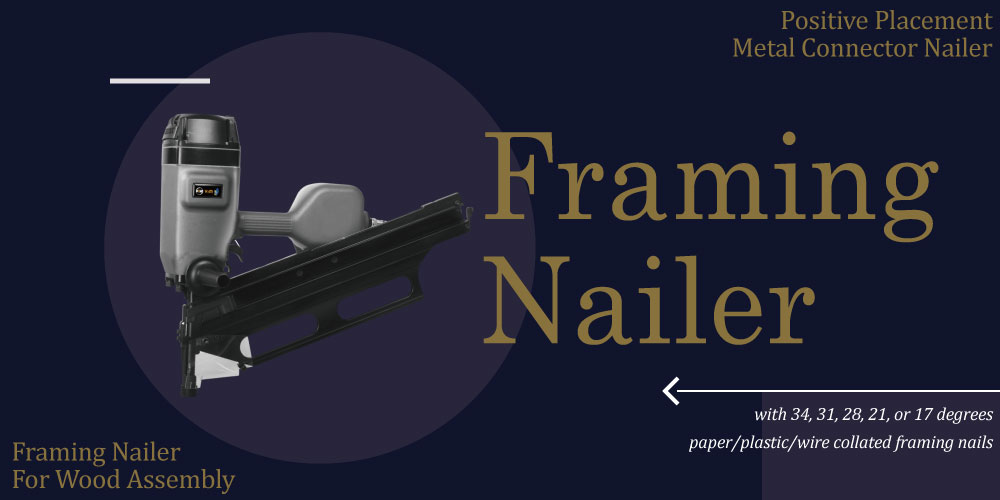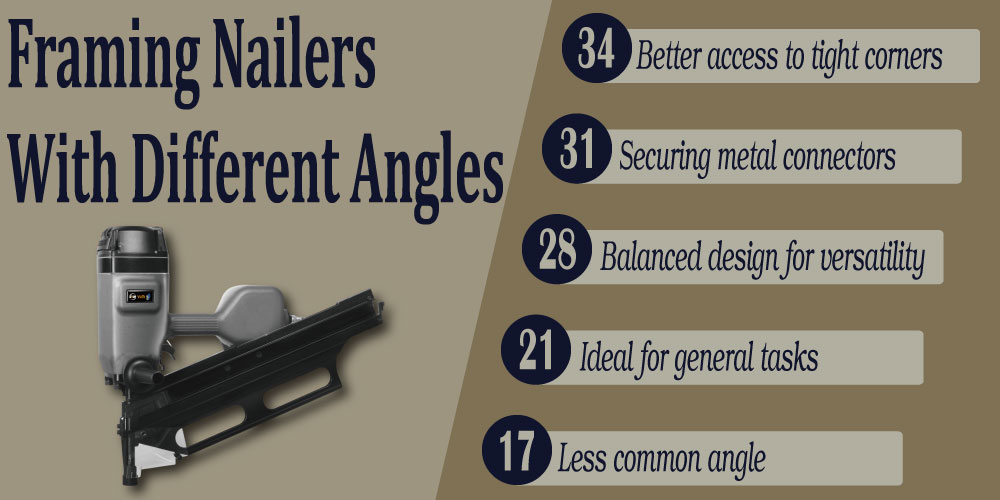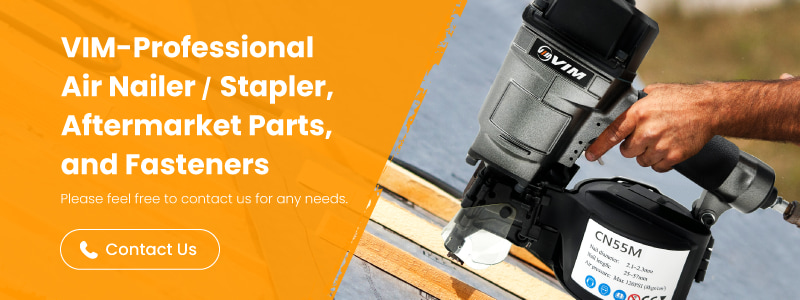Every Tip for Choosing the Best Framing Nailer

A framing nailer is a powerful construction tool designed for driving nails into wood and other materials quickly and efficiently. These tools are crucial for tasks involving large-scale wood fastening, making them ideal for heavy-duty projects such as building structural frameworks, assembling decks, or securing metal connectors.
Framing nailers come in various angles to accommodate different nailing tasks and are categorized by their specific applications, such as wood framing or metal connector installation. This article will introduce the different types, uses, and features of framing nail guns, allowing you to select the most suitable tool for your construction needs and achieve optimal results.
【Extended reading:All you need to know to choose your perfect air nailers, air staple guns, and air pliers】
What is a Framing Nailer?
 The Framing Nailer, also known as Framing Nail Gun, is a powerful tool used for driving strip nails into wood and other materials, primarily in construction projects. It is designed to fasten large pieces of wood, making it ideal for heavy-duty tasks.
The Framing Nailer, also known as Framing Nail Gun, is a powerful tool used for driving strip nails into wood and other materials, primarily in construction projects. It is designed to fasten large pieces of wood, making it ideal for heavy-duty tasks.
Framing Nail Guns typically come in various angles, such as 34, 31, 28, 21, and 17 degrees, which affect the tool’s ability to reach tight spaces, and the type of nails used. They can also be categorized based on their application to suit different type of jobs:
Positive Placement Metal Connector Nailer
Designed for connecting metal hardware, such as joist hangers or brackets, to wooden structures. It ensures precise placement of nails through pre-punched holes in metal connectors.
Framing Nail Gun for Wood Assembly
Used specifically for assembling wood frames, including tasks like wall framing, roof trusses, and floor joists. It provides the power needed to fasten large pieces of lumber together efficiently.
When Would I Need a Framing Nailer?
 A framing nailer is essential for various construction and carpentry projects, particularly when working with large wood pieces or structural components. Here are some common scenarios where a framing nailer proves invaluable:
A framing nailer is essential for various construction and carpentry projects, particularly when working with large wood pieces or structural components. Here are some common scenarios where a framing nailer proves invaluable:
1. Structural Framework
Framing nail guns are ideal for constructing the wooden framework of buildings, including wall framing, roof trusses, and floor joists. Their powerful driving force enables efficient and secure fastening of lumber, ensuring a solid and durable structure.
2. Deck and Fence Construction
If you are working on outdoor projects like building decks or fences, the framing nailers can significantly speed up the process. It provides the strength needed to fasten thick lumber, ensuring the stability and longevity of outdoor structures.
3. Sheathing and Subflooring
For tasks such as attaching plywood or other sheathing materials to walls, roofs, or floors, a framing nail gun can help you complete the job faster and more securely than traditional hammering.
4. Heavy Carpentry Work
Whether you are constructing sheds or other large wooden structures, a framing nailer is crucial for fastening large components. It allows you to drive nails quickly and precisely, reducing the effort and time required for heavy-duty carpentry.
5. Securing Metal Connector Strips
When working with metal connectors, such as joist hangers or hurricane ties, a metal connector nailer equipped with a positive placement tip ensures precise nail placement through pre-punched holes in the metal connectors, providing a secure connection.
Differences Between Framing Nailers with Different Angles
 Framing nail guns are available in various angles, from 17 to 34 degrees. These angles refer to the collation angle of the nails, which affects the nailer's performance, nail compatibility, and the situations in which they are best suited. Here is a breakdown of the differences for VIM’s framing nail guns:
Framing nail guns are available in various angles, from 17 to 34 degrees. These angles refer to the collation angle of the nails, which affects the nailer's performance, nail compatibility, and the situations in which they are best suited. Here is a breakdown of the differences for VIM’s framing nail guns:
34-Degree Framing Nailer
The 34-degree framing nailer uses clipped head or offset round head nails, which can be paper collated or wire collated. This higher angle provides better access to tight corners and narrow spaces, making it suitable for intricate framing tasks. The angled design facilitates easier maneuverability when working in confined areas, allowing for more precision.
VIM offers 34-degree framing nail guns in two lengths: 90 mm (model no. 3490FNCA3 ) and 130 mm (model no. 34130FNCA3 ). Both models are built for durability and reliable performance, catering to different project requirements. The 34130FNCA3 is designed for heavy-duty applications, such as roofing, subfloor assembly, and constructing crates and pallets, where deeper nail penetration and stronger fastening are needed. On the other hand, the 3490FNCA3 is well-suited for lighter projects, including fastening exterior decks, wall and roof sheathing, and fencing, where thinner materials are used.
31-Degree Framing Nailer
The 31-degree framing nailers, also known as positive placement metal connector nailers, are specifically designed for securing metal connectors such as joist hangers, hurricane ties, and other metal hardware to wooden structures. These nailers typically use full round head 31-degree strip nails with a pointed tip for precise placement through pre-punched holes in metal connectors, ensuring a strong and secure connection.
VIM offers two models of 31-degree framing nail guns: PM3164 (64 mm) and PM3160 (60 mm). Both models feature a positive placement tip that allows for accurate nailing in confined spaces and hard-to-reach areas, also come with other features such as 360-degree adjustable air deflector, sequential fire safety system, and rear loading design to enhance tool performance.
28-Degree Framing Nailer
The 28-degree framing nail guns typically accommodate clipped head or offset round head nails, often paper collated or wire collated. These type nailers strike a balance between nail compatibility and the ability to reach tight spots, offering a middle ground between higher and lower angled nailers. VIM’s lineup of 28-degree framing nailers includes three models with different lengths: 2890FNCA3 (90 mm), 28130FNCA3 (130 mm), and 28160FNCA3 (160 mm). Each model is suited for different project requirements. The 28160FNCA3 and 28130FNCA3 are designed for standard and heavy-duty framing tasks, such as timber framing, roof truss installation, and assembling large structures where longer nails are necessary for secure fastening. For lighter applications, the 2890FNCA3 is ideal, handling tasks where shorter nails offer sufficient holding power.
21-Degree Framing Nailer
The 21-degree framing nailers are designed for use with full round head nails that are plastic collated, making them ideal for general construction tasks.
VIM provides a range of 21-degree framing nail guns to meet various project requirements, including the 2190FNCA3 (90 mm), 21100FNCA3 (100 mm), 2130FNCA3 (130 mm), and 21160FNCA3 (160 mm). The 21160FNCA3 and 2130FNCA3 are built for demanding tasks that require deeper nail penetration, such as securing large beams or constructing robust wooden structures. The 21100FNCA3 is well-suited for standard framing tasks, such as wall framing and engineered lumber building, where strong and reliable nail fastening is essential. In contrast, the 2190FNCA3 is ideal for lighter applications where shorter nails offer sufficient holding power for secure attachment.
17-Degree Framing Nailer
The 17-degree framing nail guns typically use full round head nails and are suitable for specialized tasks that require a shallower angle. This lower angle offers a different approach to nailing in areas where higher angle framing nailers may not be ideal, providing better access and precision in certain applications.
While 17-degree framing nail guns are less common than other angles, VIM also offers one length in this category, the 1790FNCA3, which is designed to accommodate 90 mm nails. They serve specific needs in construction projects where tight spaces or unconventional nailing positions are involved.
Comparison Chart for Framing Nailers with Different Angles
| Angle | Nail Head Type | Nail Collation Type | VIM Model Available | Key Features |
|---|---|---|---|---|
| 34 Degree | Clipped Head or Offset Round Head |
Paper or Wire Collated | ● 3490FNCA3 ● 34130FNCA3 |
● Better access to tight corners. ● High precision for intricate tasks. |
| 31 Degree | Full Round Head | Paper Collated | ● PM3160 ● PM3164 |
● Ideal for securing metal connectors. |
| 28 Degree | Clipped Head or Offset Round Head |
Paper or Wire Collated | ● 2890FNCA3 ● 28130FNCA3 ● 28160FNCA3 |
● Balanced design for versatility. ● Suitable for a range of framing tasks. |
| 21 Degree | Full Round Head | Plastic Collated | ● 2190FNCA3 ● 21100FNCA3 ● 21130FNCA3 ● 21160FNCA3 |
● Ideal for general tasks. ● Offers multiple lengths for various applications. |
| 17 Degree | Full Round Head | Plastic Collated | ● 1790FNCA3 | ● Less common angle. ● Provides a unique nailing approach in confined areas. |
How to Choose the Right Framing Nailer?
 Selecting the right framing nail gun depends on the specific requirements of your project. Here are some factors to consider when choosing the best framing nailer for your needs.
Selecting the right framing nail gun depends on the specific requirements of your project. Here are some factors to consider when choosing the best framing nailer for your needs.
1. Nail Angle
Framing nail guns come in various angles, such as 17, 21, 28, 31, and 34 degrees. The angle affects the nailer’s maneuverability and the types of nails it can use.
- 34-Degree
Provides better access to tight corners and is ideal for intricate framing tasks. - 31-Degree
Designed for securing metal connectors to wood, using specialized nails for accurate placement. - 28-Degree
Offers a balanced design for a range of framing tasks. - 21-Degree
Commonly used for general construction, often required by building codes when using full round head nails. - 17-Degree
Suitable for specialized tasks with a shallower angle, allowing for more precise nailing in confined spaces.
2. Nail Head Type
 Different nailers support various nail head types, which affect their suitability for specific tasks. Selecting a nailer that matches your project's requirements and complies with local building codes is essential.
Different nailers support various nail head types, which affect their suitability for specific tasks. Selecting a nailer that matches your project's requirements and complies with local building codes is essential.
- Full Round Head
Offers maximum holding power and is often required by building codes for structural applications. - Clipped Head
Allows for higher nail capacity in the magazine but may not comply with all building codes. - Offset Round Head
Provides a balance between magazine capacity and compliance with building standards.
【Extended reading:3 Common Magazine Issues in Air Nailers and How to Fix Them】
3. Nail Collation Type
 The collation type determines how the nails are held together, impacting debris levels, nail strength, and application suitability.
The collation type determines how the nails are held together, impacting debris levels, nail strength, and application suitability.
- Plastic Collation
Typically used with full round head nails. Plastic strips break away when the nail is driven, making it suitable for outdoor use. - Paper Collation
Common for clipped or offset round head nails. Produces less debris, making it ideal for indoor projects. - Wire Collation
Often used in high-volume applications where the wire helps hold the nails together securely.
【Extended reading:A Deep Dive into Coil Nails: 5 Reasons You Should Choose Coil Nails】
4. Project Type
Different lengths of framing nailers are suitable for different projects. Generally, longer lengths are better for heavy-duty tasks, while shorter lengths are ideal for lighter construction. Using the wrong length of framing nailer can result in nails not fastening securely or causing the workpiece to split. It's important to choose the appropriate length based on the material thickness and the strength required for the task.
- Heavy-duty Projects
For tasks like roofing, timber framing, and constructing large structures, choose a model with a higher driving force, such as 130 mm or 160 mm nail length. - Standard Framing
For wall framing, assembly engineered lumber, or general carpentry, a mid-range nailer (100 mm to 130 mm) is usually suitable. - Light Construction
For lighter tasks such as installing sheathing, fencing, or exterior siding, a smaller model (90 mm) may suffice.
【Extended reading:Choosing the Right Coil Nails: 8 Essential Fctors for Your Project】
Framing Nail Gun Q&A
1. What sizes of nails can a framing nailer use?
A framing nail gun can accommodate nails in various sizes, depending on the specific model and angle. It supports 17, 21, 28, and 34-degree framing nails with lengths of 90 mm, 100 mm, 130 mm, and 160 mm. Additionally, a Positive Placement Metal Connector Nailer, typically used for more precise fastening, is compatible with 31-degree nails in 60 mm and 64 mm lengths.
2. What safety gear is required when using a framing nailer?
When using a framing nailer, it is essential to wear proper safety gear to prevent injury. Required safety equipment includes safety glasses or goggles to protect your eyes from flying debris, hearing protection such as earplugs or earmuffs to reduce noise exposure, and sturdy work gloves to protect your hands. It's also recommended to wear a hard hat and steel-toe boots, especially on construction sites, to ensure full-body safety while operating the tool.
3. What should I do if the nails won’t drive into the material?
If the nails won’t drive into the material, start by checking the air pressure—make sure your compressor is set to the recommended PSI for your framing nailer. Next, inspect the nails to confirm they are the correct type and size for your tool. Also, examine the nailer’s nosepiece for any blockages or debris that may be affecting performance. If the issue persists, check for worn or damaged internal parts such as the driver blade or seals, and consult the user manual or a professional technician for further troubleshooting.
【Extended reading:Air Nailer Troubles? 6 Trigger Issues and How to Fix Them? 】
4. How do I clean and maintain a framing nailer?
To clean and maintain a framing nailer, first disconnect it from the air supply for safety. Wipe down the exterior regularly to remove dust and debris. Use compressed air to clean the magazine and nosepiece, ensuring there’s no buildup that could cause jams. Lubricate the tool with a few drops of pneumatic tool oil in the air inlet before each use to keep internal components running smoothly. Periodically inspect and tighten screws, and check for worn or damaged parts. Regularly replace easy-wear spare parts such as the driver assembly, O-rings, bumper, and others to extend the nailer’s lifespan and keep it in peak working condition. Always refer to the manufacturer’s manual for specific maintenance guidelines to ensure optimal performance.
Conclusion
Choosing the right framing nail gun requires understanding the various options available, including nail angles, nail head types, and nail collation methods. Considering factors such as project type, nail length, and specific building code requirements ensures that you select a nailer that meets your needs.
VIM provides a wide range of framing nail guns to suit different requirements, whether you’re connecting walls to metal or constructing large structures. We can provide the right framing nailer for your project. Feel free to contact us with your requirements—we are here to assist you!
Article Classification
Recent Articles
- Avoid Costly Jams: 5 Proven Hog Ring Plier Repair Solutions that Work
- 4 Simple Ways to Maintain Your Hog Ring Plier for Better Performance
- Narrow vs Wide Crown Stapler: 3 Steps to Make the Right Choice
- Safety Starts Here: Explore 5 Smart Safety Designs in Pneumatic Nailers and Staplers
- Handheld vs. Foot-Operated Carton Staplers: Which Is Better for Your Workflow?

